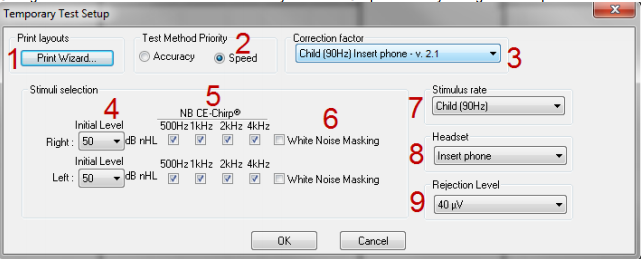Subscribe to the Interacoustics Academy newsletter for updates and priority access to online events
Training in ASSR
-
Performing an ASSR Threshold Assessment
-
What is ASSR Hearing Testing?
-
Should You Repeat the ASSR at Threshold?
-
Course: An Introduction to the CE-Chirp®
-
What is the CE-Chirp® Family of Stimuli?
-
ASSR: 95% or 99% Statistical Confidence?
-
90 Hz ASSR or ABR for Threshold Estimation?
-
40 Hz ASSR or N1-P2 for Threshold Estimation?
-
ASSR Hearing Test: An Introduction
-
ASSR Research Findings in Infants
-
Introduction to the CE-Chirp® Stimuli
-
The use of CE-Chirp® stimuli in ASSR testing
-
The role of harmonics in the detection of the ASSR response
-
ASSR signal to noise ratios increase when narrowband CE-Chirp® stimuli are used
-
Development of the Eclipse ASSR detection algorithm
-
ASSR in children using narrowband CE-Chirp® stimuli
-
How to Diagnose Mild to Moderate Hearing Loss in Children
-
Simultaneous multiple stimulation of the ASSR
-
ASSR: Una introducción
-
Getting started: ASSR
-
Performing a good ASSR
-
Running the ASSR test
ASSR Masking with Asymmetrical Hearing Function
Description
If you find an asymmetry between the ears in ASSR, can you apply masking?
It is absolutely key that any masking needs are met for accurate diagnosis and management. The principles of masking ASSR are much the same as the ABR in terms of the rules of masking and the potential for interaural cross-over of sound.
The main difference is that in ABR we only test at one frequency at a time, whereas in ASSR we might test up to 4 frequencies simultaneously. So, the potential for cross-hearing at all frequencies need to be monitored simultaneously, not just one at a time.
The other issue to bear in mind is that typically we test binaurally with the ASSR (by AC), and only monaurally with the ABR. This does not alter the fact that if there was an interaural asymmetry that was large enough for cross hearing to occur, the better hearing ear should be masked. In that case we would revert to ASSR with monaural stimulation i.e. we would continue to stimulate the test ear in the normal way, but now instead of stimulating the other ear with test stimuli, we would input masking noise to that ear instead.
For instance if we have selected white noise masking of the right ear (Number 6 in image), and so we could continue to test the left ear ASSR monaurally while the right was masked out. The masking is presented by the insert phone. The level of masking needed is chosen from the down menu in the temporary settings (Number 4 in image) (and you can work out the level of masking needed by using the ABR masking calculator (see webinar…). Of course, that tool is intended for the ABR but there is no reason why it can’t be used for ASSR too…we still use the chirp in both ABR and ASSR, the main difference being that the rate of stimulation is different, but that doesn’t affect the interaural cross-over.

So, consider using this tool to set the masker to the level necessary to cover whichever frequency shows the biggest interaural asymmetry…all the other frequencies in your ASSR test would then receive enough masking automatically. If in doubt, use the masking calculator to check all frequencies with an interaural asymmetry one by one, then set the masking level to the highest masking level recommended.
Please note that BC ASSR is also feasible, and rules of masking are also applied in the same sort of logic as above, but taking into account that BC ASSR isn’t performed at 500 Hz. Masking with BC ASSR is likely to be needed more frequently than AC ASSR, similarly to in ABR (and Pure Tone Audiometry). Please see Hansen and Small (2012) for more info.
References and caveats
Hansen, E.E., and Small, S.A. (2012) Effective Masking Levels for Bone Conduction Auditory Steady State Responses in Infants and Adults With Normal Hearing/ Ear& Hearing, 33 (2), pages 257–266
Presenter

Get priority access to training
Sign up to the Interacoustics Academy newsletter to be the first to hear about our latest updates and get priority access to our online events.
By signing up, I accept to receive newsletter e-mails from Interacoustics. I can withdraw my consent at any time by using the ‘unsubscribe’-function included in each e-mail.
Click here and read our privacy notice, if you want to know more about how we treat and protect your personal data.
